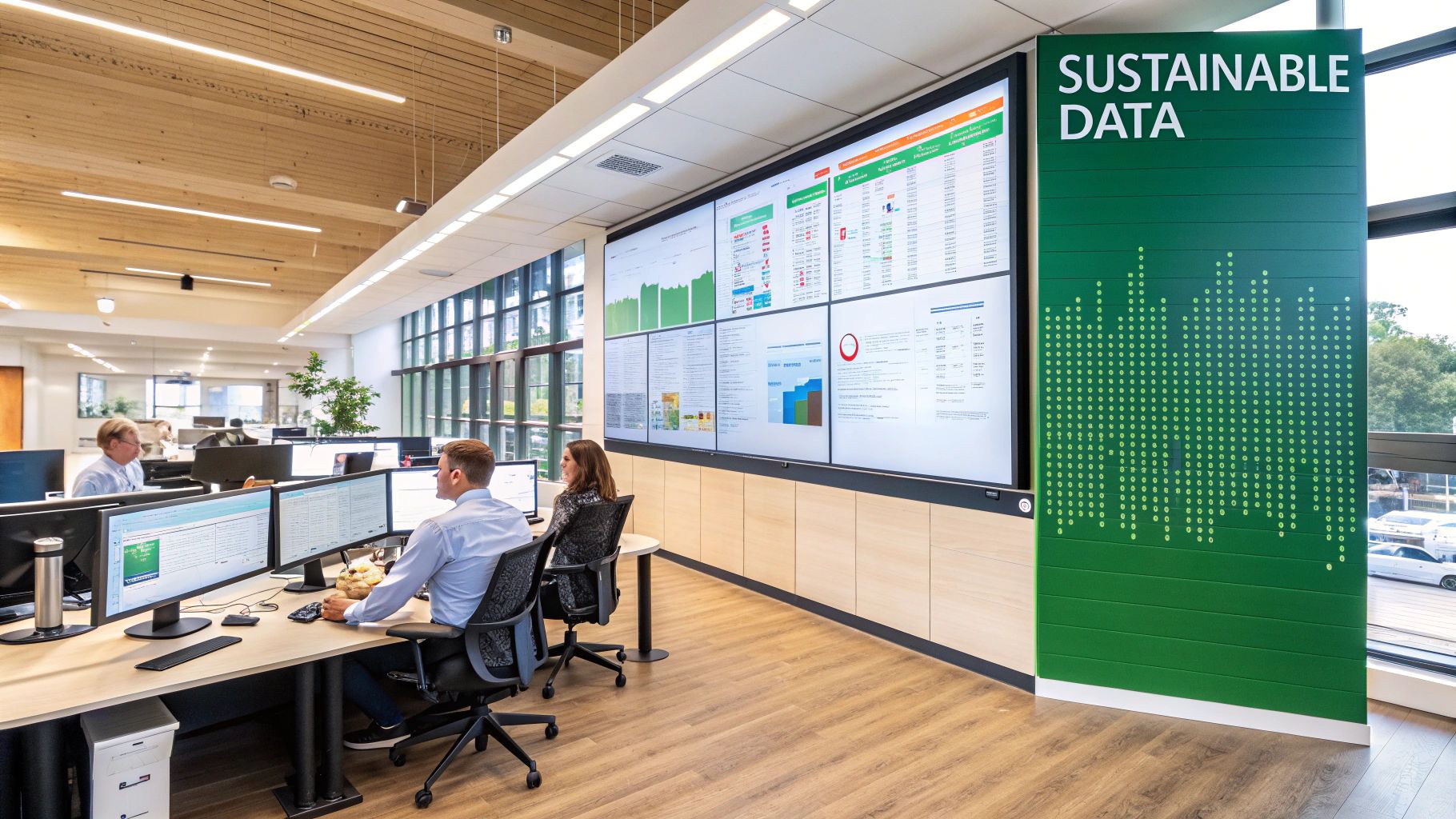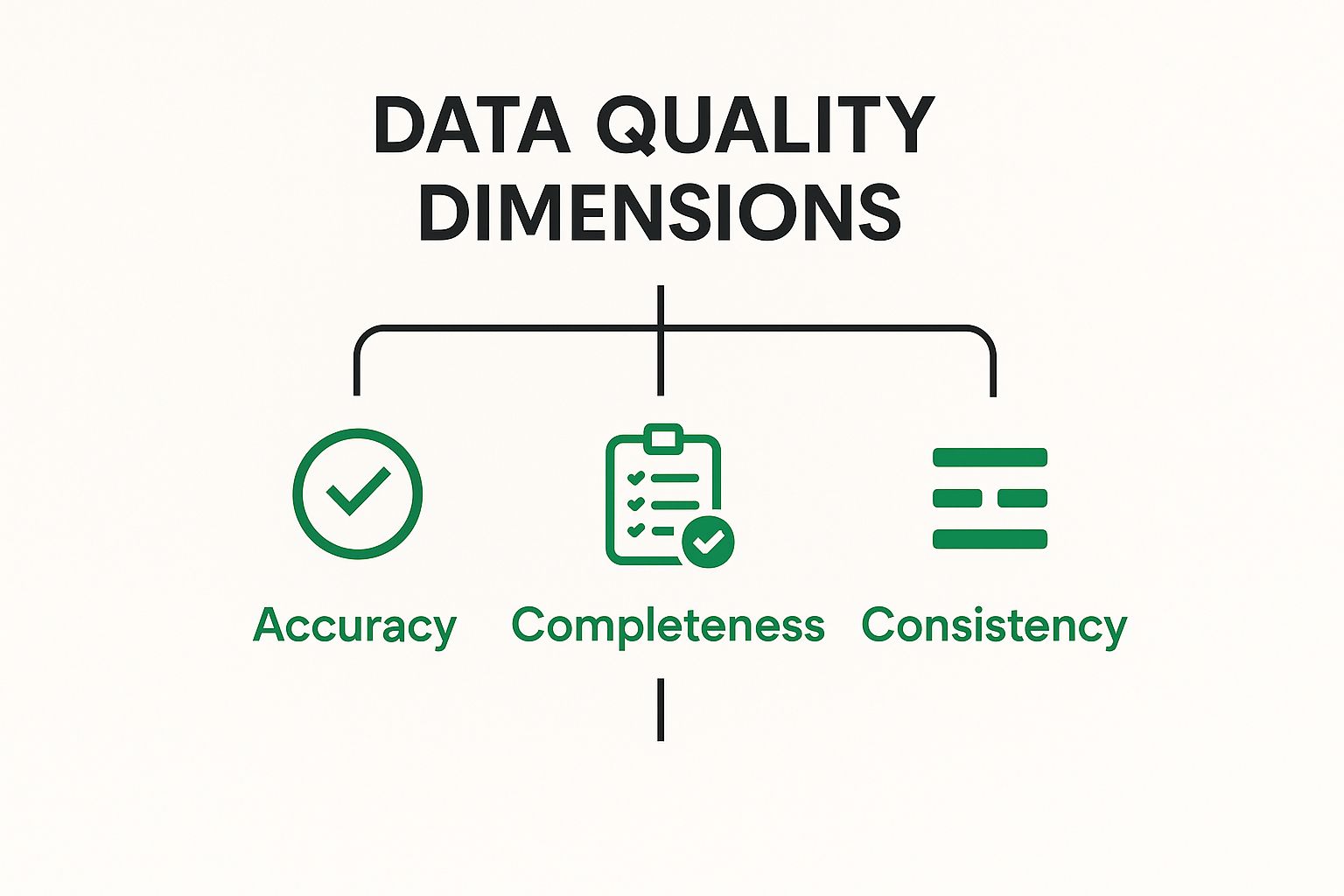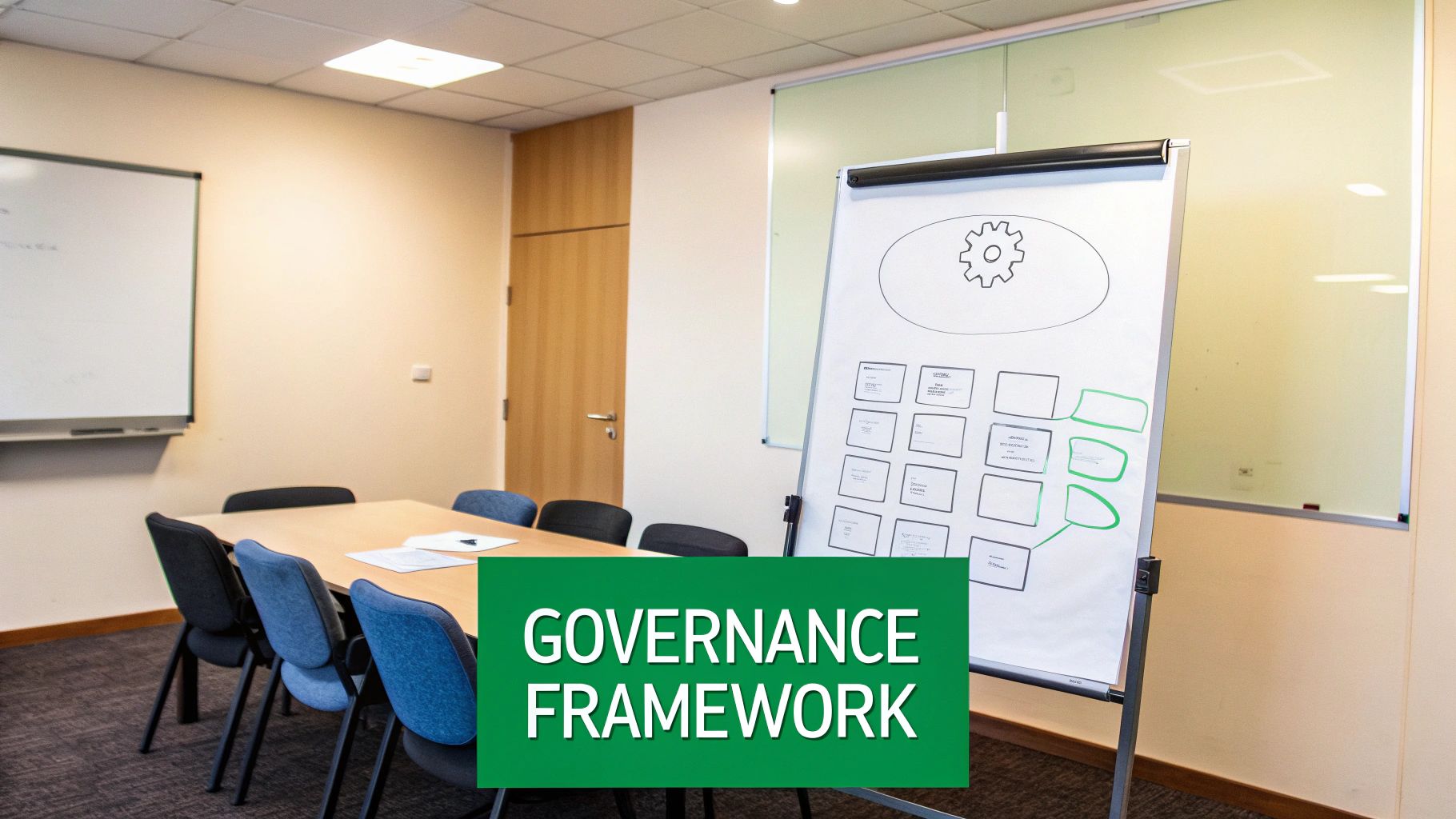Mastering Sustainability Data Governance
Karel Maly
October 1, 2025
Think of sustainability data governance as the master plan for all your company's environmental, social, and governance (ESG) information. It’s the structured system of rules and processes that takes scattered, messy metrics and turns them into a strategic asset you can actually trust. A solid governance framework is what ensures your data is accurate, reliable, and ready to stand up to scrutiny from investors, regulators, and anyone else who’s watching.
Understanding Your ESG Data Blueprint

Imagine trying to build a house without an architectural plan. You could have the best materials on the market—premium wood, strong nails, high-grade concrete—but without a clear blueprint guiding construction, you’d end up with a chaotic, unstable mess. It’s exactly the same with corporate sustainability. Without a formal system to manage ESG information, all you have is a jumble of disconnected numbers.
Sustainability data governance provides that essential blueprint. It's a formal system that sets out who has the authority to make decisions, what the policies are, and who is accountable for managing ESG data from the moment it’s collected to its final use in reports and strategic planning. The whole point is to bring order to potential data chaos, transforming it into something genuinely valuable.
From Messy Metrics to Strategic Assets
A surprising number of companies are still wrestling with spreadsheets and manual data entry to track their ESG performance. In fact, a 2024 survey found that 47% of organisations still rely on spreadsheets to manage their sustainability data. This approach isn't just slow and inefficient; it’s a recipe for errors, which can quickly erode your credibility and even lead to regulatory fines.
This is precisely the problem that effective governance solves. It establishes clear rules of the road and designates responsibilities, answering critical questions like:
- Who owns this data? By assigning clear "data stewards," you make someone directly accountable for the quality of specific metrics, whether it's carbon emissions or employee turnover rates.
- How is it defined? A shared "data dictionary" is crucial. It ensures that a term like "water usage" is measured and understood in the exact same way across every department and location.
- Is it accurate and verifiable? Governance frameworks build in automated checks and validation processes to catch errors long before they ever make it into an annual report.
By creating a single source of truth, sustainability data governance elevates your efforts from a simple box-ticking exercise to a core business function. It provides the reliable foundation needed to make intelligent decisions that drive real, long-term value.
Ultimately, this structure builds something priceless: trust. When investors, customers, and regulators know they can rely on the data you publish, your company’s reputation for transparency and commitment grows. Your sustainability programme stops being just a compliance task and starts becoming a genuine competitive advantage.
The Foundational Pillars of ESG Data Governance
A solid sustainability data governance framework is built on a few essential pillars. Each one is crucial, working together to hold up your entire ESG strategy. It's a bit like constructing a high-performance building—if one support column is shaky or out of place, you risk the integrity of the whole structure. Without these foundational elements in place, your data won't stand up to the scrutiny of regulators or stakeholders.
To build a system that lasts, you need to concentrate on four non-negotiable components. Each pillar handles a different part of the data journey, from the moment it's collected to how it's ultimately secured, creating a trustworthy process from beginning to end.
These pillars are not just abstract concepts; they are the practical cornerstones that ensure your sustainability data is reliable, transparent, and ready for action. Let's break down what they are and why they matter so much.
| Pillar | Core Function | Why It's Critical for Success |
|---|---|---|
| Data Quality & Accuracy | Ensures data is correct, complete, and consistent. | Prevents flawed analysis and poor decision-making. If your data is wrong, every report and strategy built on it will be too. |
| Data Stewardship | Assigns clear ownership for each data point and metric. | Creates accountability and a single source of truth. It answers the question, "Who is responsible for this number?" |
| Metadata Management | Creates a common "data dictionary" for the organisation. | Guarantees everyone is speaking the same language. It prevents inconsistencies and makes company-wide analysis possible. |
| Data Security & Access | Protects data from unauthorised access or changes. | Maintains data integrity and ensures compliance with privacy regulations like GDPR, safeguarding sensitive information. |
By implementing these four pillars, you're not just managing data; you're building a foundation of trust that will underpin every sustainability claim and decision your organisation makes.
Data Quality and Accuracy
First and foremost, you need to focus on data quality. The principle is straightforward: your sustainability data must be accurate, complete, and consistent. Low-quality data is worse than no data at all—it leads to flawed insights, misguided strategies, and a serious blow to your credibility. It’s the classic "garbage in, garbage out" problem, but with your reputation on the line.
This is where the real work begins. You have to ensure every number you report can be traced back to a reliable source and has been properly vetted.

As you can see, accuracy, completeness, and consistency aren't separate goals; they're interconnected elements that form the bedrock of high-quality data. If you neglect one, the others will suffer, weakening your entire governance framework.
Data Stewardship
Next up is data stewardship, which is all about assigning clear ownership. Every single ESG metric you track, from tonnes of CO₂ emissions to employee diversity statistics, needs a designated "steward." This is the person or team responsible for its accuracy, its official definition, and its entire lifecycle.
This simple act of assignment cuts through so much confusion and creates direct accountability. When someone questions a particular data point, you know exactly who has the answers. No more finger-pointing or scrambling to find the source.
Metadata Management
The third pillar, metadata management, is about creating a universal 'data dictionary' for your whole organisation. Think of it as the rulebook that defines what each metric actually means, how it's calculated, and where the data comes from. It ensures everyone is on the same page and speaking the same language.
Without good metadata, one department's "waste recycled" could mean something completely different to another's, making any kind of company-wide analysis or comparison totally meaningless.
This pillar is what guarantees consistency across different teams, regions, and business units. It’s the secret to creating a single, coherent picture of your sustainability performance.
Data Security and Access
Finally, data security is the pillar that guards all your hard work. This involves setting up clear controls to manage who can view, change, or share your sustainability data. We're not just talking about preventing leaks; we're talking about maintaining the integrity of the data itself.
Strong security protocols are absolutely essential for protecting confidential business information and ensuring you comply with privacy laws like GDPR. When combined, these four pillars create a resilient and trustworthy framework for modern sustainability data governance.
Navigating Corporate Sustainability Data Gaps

Let’s be honest: one of the toughest parts of any sustainability programme is grappling with what you don’t know. Data gaps are simply a fact of life, whether it’s missing information from a supplier buried deep in your value chain or incomplete national statistics that throw off your benchmarking. These holes appear for all sorts of reasons, from a lack of standardised metrics to a reporting landscape that seems to change by the minute.
This isn’t just some abstract problem; it has very real consequences for both countries and companies. Take the Czech Republic's own sustainability reporting. In its Voluntary National Review, data was only available for about 56% of the 169 global Sustainable Development Goal (SDG) targets. That means for nearly half the goals, there’s no internationally comparable data—a challenge that perfectly mirrors what corporations face every day. You can dig into the specifics in the official UN submission yourself.
This is precisely where good sustainability data governance really proves its worth. There’s a common myth that you need perfect, complete data before you can even think about governance. The reality is the exact opposite. A strong framework is all about creating a system to manage that imperfection and use it to drive constant improvement.
Acknowledging and Addressing Data Gaps
The first move in any solid governance strategy isn’t to pretend data gaps don't exist. It's to find them, document them, and turn them into a clear roadmap for getting better. This transforms those unknown weaknesses into concrete, actionable projects. Without this kind of structured approach, you’re just leaving yourself exposed to risk and uncertainty.
A mature governance programme doesn’t just identify gaps; it has a playbook for managing them and, over time, closing them. The aim is to build an ever-clearer, more accurate picture of your organisation’s impact, even when you can't get your hands on direct data.
Here are a few key strategies for tackling those gaps:
- Using Proxies and Estimations: When you can’t get precise data (think of a small, tier-three supplier), a good governance framework tells you which proxies or industry-average data are acceptable to use. Crucially, it also requires you to document every single assumption made.
- Leveraging Qualitative Assessments: Not everything that matters can be measured with a number. Governance can help you weave in structured qualitative information—like supplier questionnaires or findings from on-site audits—to add critical context where the numbers fall short.
- Investing in New Data Technologies: A forward-thinking governance plan should also steer investments toward new tools. Think IoT sensors on machinery or AI-driven platforms that can automatically capture data points that were once impossible to track.
The real point of good governance isn't data perfection; it's data progression. It gives you the discipline to admit what you don’t know, the methods to estimate it responsibly, and the strategy to improve your data quality year after year.
Adopting this mindset helps build trust and shows you’re serious about transparency. It’s the bedrock for creating a reliable ESG data foundation, which is essential to enhance ESG data and build investor confidence. At the end of the day, successfully navigating data gaps isn't just a task—it's one of the core functions of a great sustainability data governance programme.
How to Implement a Governance Framework
Putting a solid sustainability data governance framework into action isn't a one-and-done project. It’s much more like tending a garden—it needs thoughtful planning, consistent care, and the willingness to adapt as conditions change. Think of it as a journey that gradually builds your organisation's data maturity over time.
This journey doesn’t start with software or systems; it starts with people. The very first step is to bring together a cross-functional governance committee. You'll want people in the room from IT, finance, operations, legal, and of course, sustainability. Getting all these perspectives together from the outset is crucial for making sure the framework actually works with how the business runs day-to-day.
Once you have your team, you can get down to the real work: defining the rules of the road for your data. This isn't something one person can do alone. It's a team sport, focused on building a shared understanding of what sustainability data means to your organisation.
Defining Your Data and Policies
The committee's first big task is to figure out which ESG data points are most critical. What numbers are absolutely non-negotiable for your regulatory reports, investor updates, and strategic plans? My advice is to start small. Zero in on your most material issues first—things like Scope 1 and 2 emissions or essential workplace safety stats.
With those priorities clear, you can build clear policies around how that information gets handled. This means creating a central "data dictionary" that spells out exactly what each metric is, how it's calculated, and where the data comes from. This one step can save you from a world of pain by cutting out the ambiguity that so often leads to conflicting reports from different departments.
A well-defined policy answers the crucial questions: Who owns this data? How is it validated? How often is it collected? Documenting these processes creates a clear, auditable trail that builds trust and withstands scrutiny.
Getting this level of detail down on paper is fundamental. It’s how you turn high-level goals into concrete, repeatable steps that anyone in the organisation can follow. This is the foundation for creating data that is consistent and reliable.
Selecting Technology and Driving Improvement
Once your team and policies are in place, you can start thinking about technology. Let's be honest, trying to manage this with spreadsheets is a recipe for disaster. Manual data collection is slow and incredibly error-prone; in fact, studies show that nearly 88% of spreadsheets contain mistakes. This is where specialised software becomes a necessity, not a luxury.
You need to look for tools that can automate the entire data lifecycle. The right platform should give you:
- Automated Data Ingestion: Connectors that can pull data directly from its source, whether that's your ERP system or a utility provider's portal, cutting out manual entry.
- Built-in Validation Rules: Automated checks that can flag strange numbers or inconsistencies right away, catching quality issues at the source.
- Centralised Dashboards: A single source of truth where everyone can see the same performance data in one clear view.
- Audit-Ready Reporting: Features that can automatically generate reports formatted for major frameworks like GRI or CSRD.
For a deeper look into what makes a great tool, you can explore our detailed guide on sustainability data management software. A strong governance framework also demands robust security. For some excellent technical insights on protecting your data, it's worth reviewing the principles found in these DevOps security best practices.
Finally, remember that getting the framework implemented isn't the finish line. A truly successful setup includes a continuous feedback loop. You need to regularly review your processes, check on your data quality, and adapt to new regulations or shifting business goals. This ongoing cycle of improvement is what will turn your sustainability data governance from a simple process into a genuine strategic asset.
The Czech Corporate ESG Data Landscape

To really get why solid sustainability data governance matters, we just have to look at what's happening on the ground. For Czech businesses, the pressure for transparent, trustworthy ESG data isn’t some far-off idea anymore. It's here and now, a core part of strategy thanks to a mix of EU rules, investor expectations, and what customers want.
The Czech market is at a really interesting crossroads. A major 2022 ESG Rating looked at 87 of the country's biggest firms—companies that make up about 22% of the national GDP. The results showed a clear pattern: many businesses have made a good start, reporting on foundational environmental metrics like energy consumption and waste management. You can dive into the full details in the ESG Rating for Czech companies here.
But that same study also shines a light on the next big hurdle. While basic environmental reporting is becoming standard practice, there’s a noticeable gap when it comes to the more intricate social and governance data. This is where a company’s data maturity is truly tested.
The Leap to Advanced Disclosures
The real challenge isn't just about gathering more data. It's about handling different kinds of information that are often much tougher to measure and track consistently. Making this leap is what separates the leaders from the rest of the pack in the Czech market.
Companies often run into a few common roadblocks:
- Supply Chain Due Diligence: It’s one thing to track your own operations, but quite another to get reliable ethical and environmental data from hundreds of different suppliers.
- Social Impact Assessments: How do you put a number on your company's effect on local communities or employee well-being in a way that’s standardised and can be verified?
- Governance Metrics: Reporting on complex issues like board diversity, anti-corruption policies, or the ratio of executive pay to the average worker’s salary requires a whole new level of data management.
The companies that are getting ahead in these advanced areas aren't just better at reporting—they are better at governance. They've put the internal systems in place, assigned clear responsibility, and set up the validation checks needed to manage this complex information well.
This is a vital distinction to make. Strong sustainability data governance acts as the engine that allows Czech firms to move beyond simple metrics. It gives them the confidence to report on the sophisticated, nuanced data that investors and regulators are now asking for.
Ultimately, it provides the structure to transform what could be a compliance headache into a real competitive advantage, building trust and proving a genuine commitment to running a sustainable business.
How AI Is Shaping the Future of Governance
The future of sustainability data governance is looking a lot more intelligent and automated. For years, we’ve relied on manual data collection and sprawling spreadsheets, but that old-school approach is buckling under the weight of today’s complex information demands. AI is stepping in, changing governance from a reactive, tick-box exercise into a proactive, strategic advantage.
This shift helps us move beyond basic human limitations. Think about it: AI-powered tools can automatically pull in and standardise huge amounts of data from just about anywhere—supplier reports, utility bills, even real-time satellite imagery tracking deforestation. This isn't just about speed; it's about quality. Automation flags errors and inconsistencies that a person could easily overlook, leading to far more reliable data.
Unlocking Predictive Insights
But AI’s real game-changer isn't just cleaning up past data; it's the ability to look into the future. By crunching historical patterns and current inputs, algorithms can forecast future environmental impacts with impressive accuracy. This means companies can finally get ahead of the curve instead of just reporting on what’s already happened.
Imagine being able to:
- Forecast Emissions: Predict your carbon footprint for the next quarter based on upcoming production schedules, allowing you to make adjustments before the emissions happen.
- Identify Supply Chain Risks: Get an early warning about a potential ethical issue or disruption deep in your supply chain, giving you time to act before it becomes a full-blown crisis.
- Optimise Resource Use: Let an algorithm analyse your operational data to pinpoint hidden opportunities for cutting energy consumption or reducing waste.
This isn’t science fiction; it’s about using technology to make smarter, faster decisions. AI turns a governance programme into a dynamic engine for intelligent sustainability management, providing the insights needed to act decisively.
The strategic application of AI for sustainability reporting is already helping leading companies turn their data governance into a competitive edge. By embracing predictive analytics and automation, these organisations are not just meeting compliance requirements—they are building more resilient, efficient, and genuinely sustainable businesses.
Frequently Asked Questions
Getting started with sustainability data governance can feel like a big undertaking, and it’s natural to have questions. Let’s tackle some of the most common ones we hear from organisations finding their footing.
What Is the Best Starting Point for a Small Business?
If you’re a smaller business, the key is to start small and smart. Don't feel pressured to track every possible metric from day one. Instead, focus on what truly matters to your business—your most material ESG issues.
Pick 3-5 key areas that are most relevant to your operations and your stakeholders. This could be anything from energy consumption and waste reduction to employee safety stats. Build a simple, clear governance process around just those metrics. This focused approach keeps things manageable and helps you build a solid foundation you can expand on later.
How Do You Calculate the ROI of Data Governance?
Thinking about the return on investment for sustainability data governance purely in terms of avoiding fines is missing the bigger picture. While staying compliant is obviously a huge benefit, the real value comes from improved operational efficiency and a stronger strategic position.
Good data is like a flashlight in a dark room—it helps you spot opportunities you’d otherwise miss. You can pinpoint where you’re wasting energy, find ways to make your supply chain more efficient, and ultimately cut costs. It also builds incredible trust with investors, lenders, and customers, which can lead to better financing and a brand people genuinely want to support. A solid governance framework turns sustainability from a cost centre into a true value driver.
Good governance doesn't just manage risk; it uncovers opportunities. By ensuring your ESG data is accurate and reliable, you create a strategic asset that informs smarter business decisions and strengthens your competitive position in the market.
Ready to turn your sustainability reporting from a manual headache into a strategic asset? Carbonpunk uses AI to automate data collection, deliver audit-ready accuracy, and give you the insights needed to make a real impact. Explore our platform today.